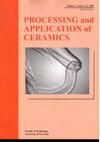Al2O3对不锈钢渣微晶玻璃中铬迁移分布及固铬效果的影响
IF 0.8
4区 材料科学
Q3 MATERIALS SCIENCE, CERAMICS
引用次数: 0
摘要
采用不锈钢渣制备微晶玻璃,可使渣中的铬(Cr)凝固。微晶玻璃制备过程中渣中铬的迁移和分布状态对微晶玻璃的固铬能力有很大影响。本文系统地研究了微晶玻璃中Al2O3含量对成核结晶过程中铬的迁移和分布以及微晶玻璃固铬效果的影响。结果表明:在成核阶段,随着Al2O3含量的增加,玻璃中形成的铬尖晶石(Cr-尖晶石)纳米晶的数量先增加后减少,玻璃相中的Cr逐渐向Cr尖晶石纳米晶迁移;TEM和XPS分析表明,在结晶过程中,Cr-尖晶石中的一部分Cr扩散到透辉石晶格中,另一部分Cr仍存在于透辉石包裹的Cr-尖晶石中。玻璃相中的铬也随着透辉石晶体的形成而扩散迁移到透辉石晶格中。最佳Al2O3含量为11.8wt。%,结果为97.94wt。总Cr的%被固定在透辉石晶相中。当铬浸出浓度为0.004mg/l时,其固铬能力非常高。研究结果为提高固铬率,实现不锈钢渣的无害化、高价值利用提供了理论和技术支持。本文章由计算机程序翻译,如有差异,请以英文原文为准。
Effect of Al2O3 on migration and distribution of chromium and chromium fixation effect in stainless-steel slag glass-ceramics
Stainless-steel slag was used to prepare glass-ceramics, which could solidify chromium (Cr) in the slag. The migration and distribution state of chromium in the slag during the preparation of the glass-ceramics have a great influence on the chromium fixation ability of the glass-ceramics. In this paper, the effects of Al2O3 content in the glass-ceramics on the migration and distribution of chromium during the nucleation and crystallization steps, and on the chromium fixation effect of the glass-ceramics were systematically studied. The results show that in the nucleation stage, with the increase of Al2O3 content, the number of chromium spinel (Cr-spinel) nanocrystals formed in the glass first increases and then decreases, and Cr in the glass phase gradually migrates to Cr-spinel nanocrystals. TEM and XPS analyses show that during crystallization, part of Cr in Cr-spinel diffuses into diopside lattice, and the other part of Cr still exists in Cr-spinel wrapped by diopside. Cr in the glass phase also diffuses and migrates into the diopside lattice with the formation of diopside crystals. The optimal Al2O3 content is 11.8wt.%, which results in 97.94wt.% of the total Cr being fixed in the diopside crystalline phase. The ability of chromium fixation is very high giving a very low Cr leaching concentration of 0.004mg/l. The research results provide theoretical and technical support for increased chromium fixation and realizing harmless and high-value utilization of stainless-steel slag.
求助全文
通过发布文献求助,成功后即可免费获取论文全文。
去求助
来源期刊

Processing and Application of Ceramics
MATERIALS SCIENCE, CERAMICS-
CiteScore
1.90
自引率
9.10%
发文量
14
审稿时长
10 weeks
期刊介绍:
Information not localized
 求助内容:
求助内容: 应助结果提醒方式:
应助结果提醒方式:


